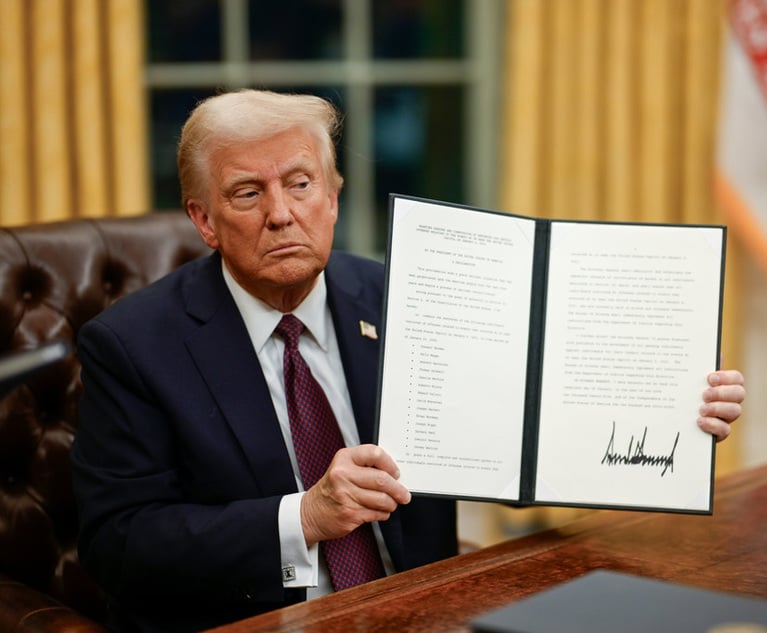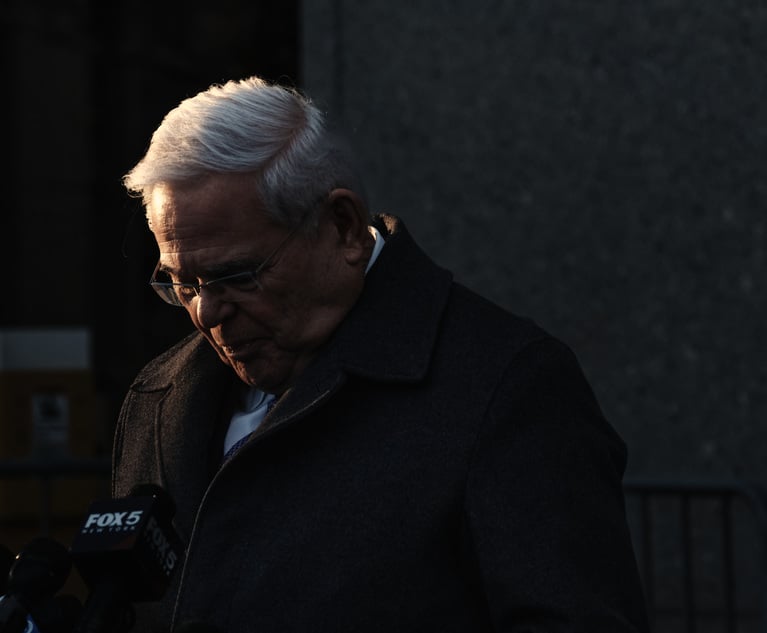Labor Dept. Clarifies Joint Employment Standard Under FLSA
In their Employment Law column, Jeffrey Klein and Nicholas Pappas analyze the "Final Rule" issued by the U.S. Department of Labor to clarify the joint employer test for businesses. In their article, they consider the extent to which the rule provides clarity to employers and reduces the risk of joint employer liability. They also provide some practical guidance for employers to reduce the risk of joint employer liability under the FLSA.
February 04, 2020 at 10:00 AM
10 minute read
 Jeffrey S. Klein and Nicholas J. Pappas
Jeffrey S. Klein and Nicholas J. Pappas
Companies frequently contract out specific services needed for their businesses in order to improve efficiency or to reduce costs associated with directly employing individual workers. Use of third parties to contract for services such as transportation, food services, cleaning or photocopying has become ubiquitous in today's economy. Staffing companies in particular, have created business based on such contracting arrangements to take on the responsibility for compensating workers performing services for the business, reporting to taxing authorities, and providing health benefits to the workers.
Although companies using contractors undoubtedly have sound business reasons for using such arrangements, such conduct also can unwittingly create legal risks under the Fair Labor Standards Act (FLSA). Specifically, under the FLSA, courts and administrative agencies have developed the so-called "joint employer" theory, which provides that two ostensibly separate companies may be treated as "joint employers" of the same workers, and thereby share responsibility for each company's wage and hour law violations.
Historically, whether or not a company would be deemed a joint employer under the FLSA depended upon jurisdiction specific multi-factor tests for which there were few bright line rules. However, on Jan. 12, 2020, the U.S. Department of Labor (DOL) issued a final rule (effective March 16, 2020) to clarify the joint employer test for businesses (the Final Rule). In doing so, the DOL sought to reduce the risk of joint employment liability for businesses.
In this month's column, we analyze the Final Rule, consider the extent to which the rule provides clarity to employers and reduces the risk of joint employer liability in certain circumstances, and provide some practical guidance for employers to reduce the risk of joint employer liability under the FLSA.
Background
The Final Rule updates and revises the DOL's prior articulation of the joint employment standard, which is codified in 29 C.F.R. §791.2. The DOL's changes to the rule are the first meaningful revisions to the regulation in more than 60 years. According to the DOL, the purpose of the new rule is "to promote certainty for employer and employees, reduce litigation, promote greater uniformity among court decisions and encourage innovation in the economy." See Joint Employer Status Under the Fair Labor Standards Act, 85 FR 2820 (Jan. 16, 2020). Business advocates have applauded the rule as a welcome policy that provides certainty for employers, while worker-side groups have criticized the rule as making employees vulnerable to abuses by employers.
Pursuant to the FLSA regulation, a joint employment relationship "generally" exists when: (1) the employers have an arrangement to share the employee's services; (2) one employer is acting directly or indirectly in the interest of the other employer; or (3) the employers directly or indirectly "share control of the employee" because one entity controls, is controlled by, or is under common control with the other. See Joint Employment, 29 CFR §791.2 (Aug. 18, 1961).
In 2016, the DOL, under the Obama administration, issued an Administrative Interpretation regarding joint employment under the FLSA regulation (the 2016 AI). The 2016 AI focused on the potential employee's "economic dependence" on the "potential joint employer" as the critical inquiry. See Administrator's Interpretation No. 2016-1 (Jan. 20, 2016). The 2016 AI moved away from the common law test that focused on whether the level of control the potential employer had over the employee and heavily favored a finding of joint employer status in many situations.
However, even in the aftermath of the 2016 AI, companies nonetheless were required to wade through an amalgam of judicial interpretations to determine if a joint employer relationship existed. For example, in the Second Circuit potential joint employers were subject to a ten-factor test. Zheng v. Liberty Apparel Co., 355 F.3d 61, 71 (2d Cir. 2003). In the Ninth Circuit, courts used a four-factor test, which the DOL ultimately adopted in the Final Rule. Bonnette v. California Health & Welfare Agency, 84 FR 14043 (April 9, 2019).
By contrast, a 2017 decision by the Fourth Circuit Court of Appeals articulated an entirely different test that criticized the joint employment tests of other circuits because those circuits focused on the relationship between the worker and the potential joint employer, while the Fourth Circuit believed the focus should instead be on the relationship between the alleged joint employers. Salinas v. Commercial Interiors, 848 F.3d 125 (4th Cir. 2017).
The existence of so many multi-factor tests created uncertainty for companies, particularly those that conduct business in multiple jurisdictions. The Final Rule seeks to resolve this uncertainty by providing a uniform test for determining joint employer status.
The Final Rule
The Final Rule discusses two joint employer scenarios: (1) where an employee's hours worked for one employer simultaneously benefits another employer; and (2) where the employee works separate sets of hours for different employers in the same workweek.
An example of scenario one is a situation in which an office park hires a janitorial service company for cleaning services. Under the contract, the office park pays the janitorial services a fixed fee for the serves and reserves the right to supervise the janitorial employees. See Joint Employer Status Under the Fair Labor Standards Act, 85 FR 2820 (Jan. 16, 2020). An example of the second scenario would be a cook who might work several hours a week for one restaurant, and also works additional hours in the same week at a different restaurant where both restaurants are affiliated with the same nationwide franchise. Id. However, the restaurants different franchisees locally own and manage each restaurant and do not coordinate with each other regarding the employee. Id.
Under the first scenario, the DOL assesses joint employer status based on whether the potential joint employer (the office park) is acting directly or indirectly in the interests of the direct employer (the janitorial services company). See Joint Employer Status Under the Fair Labor Standards Act, 85 FR 2820 (Jan. 16, 2020). In determining whether a joint employment relationship exists under the first scenario, the DOL asks courts to use the following four-factor test that analyzes whether the alleged joint employer: (1) hires or fires the employee; (2) supervises and controls the employee's work schedules or conditions of employment to a substantial degree; (3) determines the employee's rate and method of payment; and (4) maintains the employee's employment records. Id.
The DOL notes in the Final Rule that a potential joint employer must do more than merely have the ability to exercise the powers under the test. Id. Rather, the potential joint employer must actually exercise such power. Id. Further, the weight given to each factor in making a joint employment determination will vary depending on these facts. Id. The DOL also stated that the fourth factor—maintenance of employment records—alone is not sufficient to support a joint employment relationship determination. Id.
In applying these factors to the first scenario noted above, where an office park hires a janitorial service, under the Final Rule the office park would not be a joint employer. Even though the office park retained the right to supervise the employee, it does not actually hire or fire the employees, determine their rate or method of payment, or exercise control over their conditions of employment. Id.
With respect to the second scenario, where the employee works separate sets of hours for different employers in the same workweek, the DOL did not make changes to the existing standard under the prior regulation. Under this standard, so long as the potential joint employers are acting "entirely independently of each other" and are "completely dissociated" with respect to workers there is no joint employment relationship. In order to find that two entities are sufficiently associated with each other regarding an employee, the regulation analyzes whether: (1) there is an agreement to share the employee's services; (2) one entity is acting directly or indirectly in the interest of the other; or (3) the employers share direct or indirect control over the worker because one entity controls, is controlled by, or is under common control with the other. Id.
Applying these factors to the second scenario noted above, where a cook works for two separate but affiliated restaurants in the same week, the restaurants would not be joint employers under the Final Rule. Id. The cook does similar work at both restaurants and the restaurants are part of the same nationwide franchise. Id. However, those facts alone do not bear on whether the restaurants are acting directly or indirectly in each other's interest in relation to the cook. Id.
The Final Rule provides guidance to employers regarding certain common business relationships that the DOL notes, "do not make joint employer status more or less likely [.]" For example, the Final Rule notes that "[o]perating as a franchisor or entering into a brand and supply agreement, or using a similar business model does not make joint employer status more likely [.]" Id.
Further, joint employer status is not more or less likely where entities enter into contractual agreements that require the direct employer to meet certain standards to protect the health or safety of the employees or the public. Id. Examples of these standards include mandating compliance with the FLSA, performing background checks on employees or instituting sexual harassment policies. Id. The Final Rule also notes that a potential joint employer who requires quality control standards to "to ensure the consistent quality of the work product, brand, or business reputation do not make joint employer status more or less likely [.]" Id.
Strategies for Employers
The Final Rule likely will benefit a variety of companies particularly those that enter into franchise agreements, use subcontractors or engage with staffing agencies to provide temporary workers. However, employers who enter into these types of business arrangements should use caution before relying exclusively on the Final Rule.
While federal courts must defer to the DOL's regulations under the FLSA, the level of deference depends on whether the regulations are "legislative" or "interpretive." Legislative rules carry the force of law, while interpretive rules are merely persuasive. See, e.g., Perez v. Mortg. Bankers Ass'n, 575 U.S. 92, 97 (2015) (noting that interpretive rules "do not have the force and effect of law and are not accorded that weight in the adjudicatory process"). The DOL itself refers to the Final Rule as interpretive, which may signal to courts that they have discretion over the amount of deference given to the rule, if any. See Joint Employer Status Under the Fair Labor Standards Act, 85 FR 2820 (Jan. 16, 2020).
Employers should review their contractor arrangements that could result in a joint employment finding with outside employment counsel to ensure compliance with law. In particular, when employers have operations in multiple jurisdictions that impose different judicially created multi-factor joint employment tests they should consider reviewing such arrangements.
Employers also should consider including indemnification clauses in their agreements with franchisees and other third parties that could implicate the joint employer rule. Such indemnification clauses should clearly state that the direct employer is solely responsible for any liability associated with employment. However, employers should consult with their employment counsel regarding the appropriate scope of indemnification clauses and their enforceability.
Jeffrey S. Klein and Nicholas J. Pappas are partners in the Employment Litigation Practice group at Weil, Gotshal & Manges. Christopher Dyess, an associate at the firm, assisted in the preparation of this article.
This content has been archived. It is available through our partners, LexisNexis® and Bloomberg Law.
To view this content, please continue to their sites.
Not a Lexis Subscriber?
Subscribe Now
Not a Bloomberg Law Subscriber?
Subscribe Now
NOT FOR REPRINT
© 2025 ALM Global, LLC, All Rights Reserved. Request academic re-use from www.copyright.com. All other uses, submit a request to [email protected]. For more information visit Asset & Logo Licensing.
You Might Like
View All


'You Became a Corrupt Politician': Judge Gives Prison Time to Former Sen. Robert Menendez for Corruption Conviction
5 minute readLaw Firms Mentioned
Trending Stories
- 1Uber Files RICO Suit Against Plaintiff-Side Firms Alleging Fraudulent Injury Claims
- 2The Law Firm Disrupted: Scrutinizing the Elephant More Than the Mouse
- 3Inherent Diminished Value Damages Unavailable to 3rd-Party Claimants, Court Says
- 4Pa. Defense Firm Sued by Client Over Ex-Eagles Player's $43.5M Med Mal Win
- 5Losses Mount at Morris Manning, but Departing Ex-Chair Stays Bullish About His Old Firm's Future
Who Got The Work
J. Brugh Lower of Gibbons has entered an appearance for industrial equipment supplier Devco Corporation in a pending trademark infringement lawsuit. The suit, accusing the defendant of selling knock-off Graco products, was filed Dec. 18 in New Jersey District Court by Rivkin Radler on behalf of Graco Inc. and Graco Minnesota. The case, assigned to U.S. District Judge Zahid N. Quraishi, is 3:24-cv-11294, Graco Inc. et al v. Devco Corporation.
Who Got The Work
Rebecca Maller-Stein and Kent A. Yalowitz of Arnold & Porter Kaye Scholer have entered their appearances for Hanaco Venture Capital and its executives, Lior Prosor and David Frankel, in a pending securities lawsuit. The action, filed on Dec. 24 in New York Southern District Court by Zell, Aron & Co. on behalf of Goldeneye Advisors, accuses the defendants of negligently and fraudulently managing the plaintiff's $1 million investment. The case, assigned to U.S. District Judge Vernon S. Broderick, is 1:24-cv-09918, Goldeneye Advisors, LLC v. Hanaco Venture Capital, Ltd. et al.
Who Got The Work
Attorneys from A&O Shearman has stepped in as defense counsel for Toronto-Dominion Bank and other defendants in a pending securities class action. The suit, filed Dec. 11 in New York Southern District Court by Bleichmar Fonti & Auld, accuses the defendants of concealing the bank's 'pervasive' deficiencies in regards to its compliance with the Bank Secrecy Act and the quality of its anti-money laundering controls. The case, assigned to U.S. District Judge Arun Subramanian, is 1:24-cv-09445, Gonzalez v. The Toronto-Dominion Bank et al.
Who Got The Work
Crown Castle International, a Pennsylvania company providing shared communications infrastructure, has turned to Luke D. Wolf of Gordon Rees Scully Mansukhani to fend off a pending breach-of-contract lawsuit. The court action, filed Nov. 25 in Michigan Eastern District Court by Hooper Hathaway PC on behalf of The Town Residences LLC, accuses Crown Castle of failing to transfer approximately $30,000 in utility payments from T-Mobile in breach of a roof-top lease and assignment agreement. The case, assigned to U.S. District Judge Susan K. Declercq, is 2:24-cv-13131, The Town Residences LLC v. T-Mobile US, Inc. et al.
Who Got The Work
Wilfred P. Coronato and Daniel M. Schwartz of McCarter & English have stepped in as defense counsel to Electrolux Home Products Inc. in a pending product liability lawsuit. The court action, filed Nov. 26 in New York Eastern District Court by Poulos Lopiccolo PC and Nagel Rice LLP on behalf of David Stern, alleges that the defendant's refrigerators’ drawers and shelving repeatedly break and fall apart within months after purchase. The case, assigned to U.S. District Judge Joan M. Azrack, is 2:24-cv-08204, Stern v. Electrolux Home Products, Inc.
Featured Firms
Law Offices of Gary Martin Hays & Associates, P.C.
(470) 294-1674
Law Offices of Mark E. Salomone
(857) 444-6468
Smith & Hassler
(713) 739-1250







